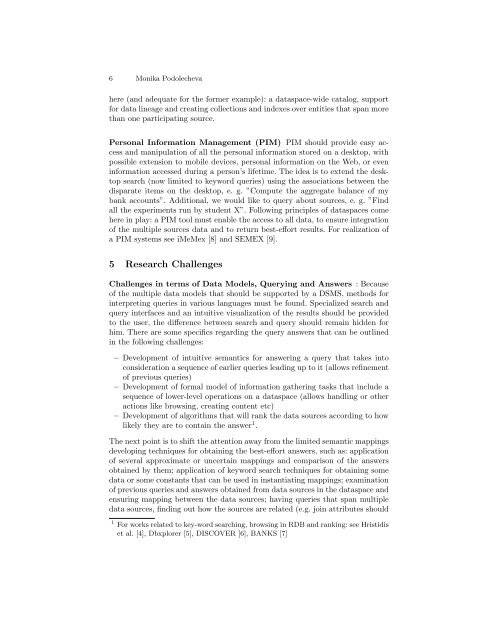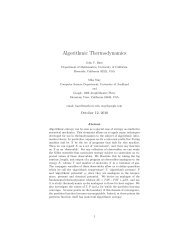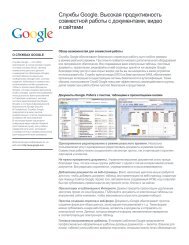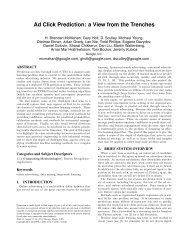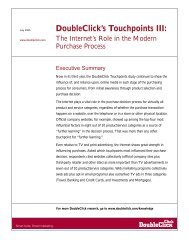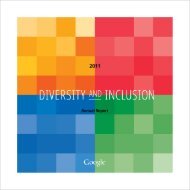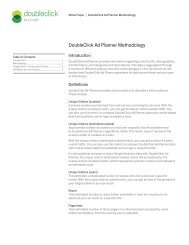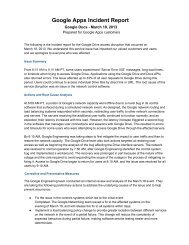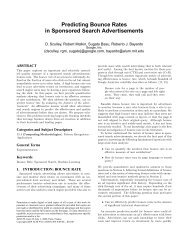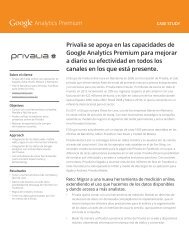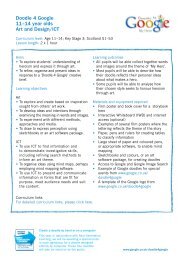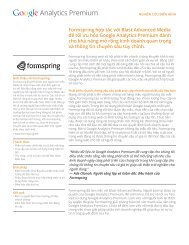Principles of Dataspaces
Principles of Dataspaces
Principles of Dataspaces
Create successful ePaper yourself
Turn your PDF publications into a flip-book with our unique Google optimized e-Paper software.
6 Monika Podolechevahere (and adequate for the former example): a dataspace-wide catalog, supportfor data lineage and creating collections and indexes over entities that span morethan one participating source.Personal Information Management (PIM) PIM should provide easy accessand manipulation <strong>of</strong> all the personal information stored on a desktop, withpossible extension to mobile devices, personal information on the Web, or eveninformation accessed during a person’s lifetime. The idea is to extend the desktopsearch (now limited to keyword queries) using the associations between thedisparate items on the desktop, e. g. ”Compute the aggregate balance <strong>of</strong> mybank accounts”. Additional, we would like to query about sources, e. g. ”Findall the experiments run by student X”. Following principles <strong>of</strong> dataspaces comehere in play: a PIM tool must enable the access to all data, to ensure integration<strong>of</strong> the multiple sources data and to return best-effort results. For realization <strong>of</strong>a PIM systems see iMeMex [8] and SEMEX [9].5 Research ChallengesChallenges in terms <strong>of</strong> Data Models, Querying and Answers : Because<strong>of</strong> the multiple data models that should be supported by a DSMS, methods forinterpreting queries in various languages must be found. Specialized search andquery interfaces and an intuitive visualization <strong>of</strong> the results should be providedto the user, the difference between search and query should remain hidden forhim. There are some specifics regarding the query answers that can be outlinedin the following challenges:– Development <strong>of</strong> intuitive semantics for answering a query that takes intoconsideration a sequence <strong>of</strong> earlier queries leading up to it (allows refinement<strong>of</strong> previous queries)– Development <strong>of</strong> formal model <strong>of</strong> information gathering tasks that include asequence <strong>of</strong> lower-level operations on a dataspace (allows handling or otheractions like browsing, creating content etc)– Development <strong>of</strong> algorithms that will rank the data sources according to howlikely they are to contain the answer 1 .The next point is to shift the attention away from the limited semantic mappingsdeveloping techniques for obtaining the best-effort answers, such as: application<strong>of</strong> several approximate or uncertain mappings and comparison <strong>of</strong> the answersobtained by them; application <strong>of</strong> keyword search techniques for obtaining somedata or some constants that can be used in instantiating mappings; examination<strong>of</strong> previous queries and answers obtained from data sources in the dataspace andensuring mapping between the data sources; having queries that span multipledata sources, finding out how the sources are related (e.g. join attributes should1 For works related to key-word searching, browsing in RDB and ranking: see Hristidiset al. [4], Dbxplorer [5], DISCOVER [6], BANKS [7]


